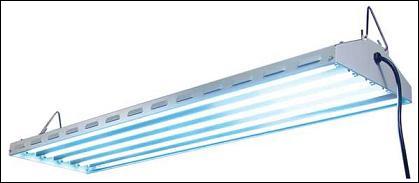Fluorescent Tubes

Fluorescent tube fixtures are an extremely common source of hydroponic lighting. However, they have some limits which could affect system performance and profitability.
Welcome to our page about fluorescent lighting. While fluorescent tube lighting is now extremely commonplace, it also has specific applications for starting and growing seedlings. Let's take a look at where they work, and where they may not be the best option.
Advantages and Disadvantages
Most hydroponics books no longer list these fixtures as
growing area options. Strictly speaking, they don't even qualify as being HID
light sources. But they are so commonly available that many people still use
them. For that reason alone I've included them in this HID lighting comparison.
Fluorescent tubes are extremely common, relatively cheap, moderately long-lived
lighting fixtures which seem a natural solution for folks just getting into
indoor plant production. Aside from the advantages already mentioned, they are
available in a wide range of spectrums, from cool white to full spectrum to
plant-growth stimulating wavelengths. The tubes are fragile in and of
themselves but the fixtures can be nearly bombproof if you need them to be, and
the fixtures almost always have built-in ballasts. They do not put off any
detectable heat so they can be located immediately next to even tender young
seedlings without damage. And the fixtures are lightweight enough that they can
be hung from a wide variety of homemade supports, and easily raised or lowered
according to the plants' requirements. Best of all, if a tube breaks, the
replacement tube is as convenient as visiting the nearest hardware store.
Unfortunately, fluorescents have some serious disadvantages. First, they do not
actually put out a lot of light compared to other grow lights. Any room with
ceiling heights much beyond 8' needs to have nearly continuous fluorescent tube
coverage to provide for anything close to the amount of brightness really
needed by plants. Anything less than that will result in leggy growth which
will fall over, wilt or simply burn up once subjected to natural sunlight. If
plants are allowed to mature under fluorescent tubes, they may never reach
maturity but simply grow ever more spindly and pathetic, eventually dying of
light starvation.
Secondly, these fixtures may be more energy-efficient than incandescent bulbs,
but they are far inferior to modern HID lights such as metal halide and high
pressure sodium. That's because they put out so few lumens compared to their
wattage. A single 4' long, two-tube fluorescent fixture may be rated at 100w,
won't put out enough light to keep a single tray of lettuce plants happy for
very long. Replace that fixture with a 100w metal halide light fixture, and
your lettuce will grow very nicely. Same power requirements for both, but the
metal halide puts out much, much more light.
Yet these bulbs have a solid place with seedling development precisely because
they provide low heat, good light coverage (even if it is at relatively low
levels) and relatively lightweight fixtures. And conveniently a 4' shop light
just perfectly fits over a bench with four trays. Put that shop light on chains
so that you can raise it one or two links per day, and your plants will get off
to a better start than if you had used a single metal halide far above them. If
for no other purpose, seedling starts will probably continue to favor
fluorescent bulb fixtures for some time to come.
Where to Find Fluorescent Tube Fixtures for Hydroponic Systems
Fluorescent
lighting has been around for several decades now, and a wide variety of
configurations are very easy to find. Most hardware stores, home improvement
stores and industrial supply houses will carry them. If you only need one or
two fixtures, your nearest hardware store would probably be the simplest way to
buy them.
Specialty hydroponics and general commercial nursery or greenhouse equipment
suppliers may very well not sell these fixtures for two reasons. First, these
fixtures are no longer considered a good solution for most growing
circumstances, so these specialty suppliers wouldn't sell many of them.
Secondly, the big-box home improvement stores go through so many of them that
they can stock them at much lower prices. So that would be your best bet. One
example can be seen at Home Depot's website, which lists a wide range of fluorescent
tube fixtures.